
a.
The
a.
Answer to Problem 9.7P
The equilibrium price is $400, producer surplus is $20,000 and consumer surplus is $16,000.
Explanation of Solution
The demand for the broccoli is given by,
Equilibrium is a point where the demand and supply curve meet. Hence this point will be,
Hence the equilibrium price is $120. Now substitute this value in above equation, we get,
Hence the equilibrium quantity is 400 units. Now the total expenditure is calculated as follows,
Now the consumer surplus is calculated by as follows,
Hence the consumer surplus is $16,000.
Now the producer surplus is calculated below,
Hence, the producer surplus is $20,000.
Introduction:Consumer surplus is a difference between the amount which consumer actually pays and the amount which he is willing to pay.
Producer surplus is the difference between what the consumer is willing to accept for a given quantity of money or good and the how much a person actually receives by selling the good in the market at the prevailing prices.
b
To describe: The total loss in consumer surplus and producer surplus, provided some values are changed.
b
Answer to Problem 9.7P
Hence the new consumer surplus is $12,000 and new producer surplus is $15,000.
Explanation of Solution
Suppose Q= 300, the total consumer surplus is calculated as follows,
=
Thus the new consumer surplus is $12,000 and it is decreased by the amount of $4,000. Now the producer surplus is calculated by as follows,
Thus the new producer surplus is $15,000 and it is decreased by the amount of $5,000.
Introduction: Consumer surplus is a difference between the amount which consumer actually pays and the amount which he is willing to pay.
Producer surplus is the difference between what the consumer is willing to accept for a given quantity of money or good and the how much a person actually receives by selling the good in the market at the prevailing prices.
c.
To describe: The allocation of producer and consumer surplus between suppliers and demanders are dependent upon the price at which broccoli is sold.
c.
Answer to Problem 9.7P
As the equilibrium price increases, consumer surplus will decreased by $7,000 and producer surplus will increased by $8,800. If price will be $95 then producer surplus is decreased by $8,750 and consumer surplus is decreased by $11,562.50.
Explanation of Solution
Let the equilibrium price P = $140, then consumer surplus is calculated as follows,
As the equilibrium price is increased, the consumer surplus will decreased by $7,000.
Now the producer surplus will be,
As the equilibrium price is increased, producer surplus will increased by $8,800.
Now assume the equilibrium price is $95 then the consumer surplus will be,
Thus consumer surplus is decreased by $11,562.50. Now the producer surplus will be,
Thus, the producer surplus is decreased by $8,750.
Introduction: Consumer surplus is the difference between the amount a consumer spends to purchase a commodity versus the amount he willingly wants to spend on the purchase.
Producer surplus is the difference between what the consumervoluntarily want to accept for a particular amount quantity of money or quantity of good and how much a person actually generates by selling the good in the market at the existing prices.
d.
To describe: The total loss of
d.
Answer to Problem 9.7P
Thus the consumer surplus is increased by $2,000 and producer surplus is increased by $2,500.
Explanation of Solution
Let
Thus the consumer surplus is increased by $2,000. Now calculate the producer surplus,
Thus the producer surplus is increased by $2,500.
Introduction: Equilibriumpoint is that point at which demand and supply curve cut each other. At equilibrium quantity demanded is always equal to quantity supplied.
e.
To describe: The graph of results.
e.
Answer to Problem 9.7P
The graphs of all the results are given below.
Explanation of Solution
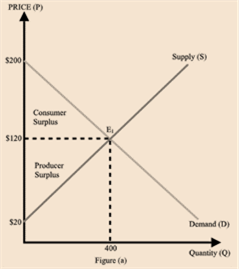
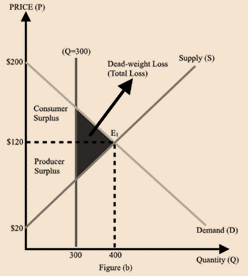
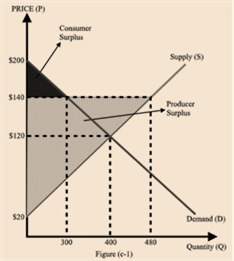
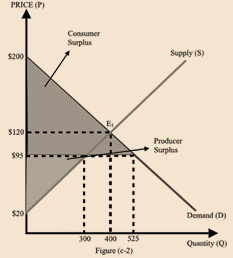
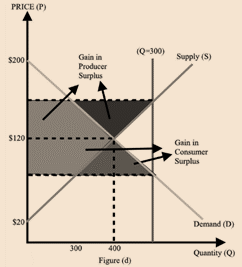
Here, the price shows in Y-axis and quantity shows in X-axis. Here fig (a) shows the equilibrium point at 400 and the equilibrium price is $120. The fig (b) shows that the equilibrium price is reduced to 300 from 400. The blue area shows the loss. The fig (c) shows the variation in equilibrium price from $120 to $95. The fig(d) represents the increased quantity from 300 to 450.
Introduction: Consumer surplus is a difference between the amount which consumer actually pays and the amount which he is willing to pay.
Producer surplus is the difference between what the consumer is willing to accept for a given quantity of money or good and the how much a person actually receives by selling the good in the market at the prevailing prices.
Want to see more full solutions like this?
Chapter 9 Solutions
EBK INTERMEDIATE MICROECONOMICS AND ITS
- Suppose the market for pizzas in the U.S. is perfectly competitive and is characterized by the following demand and supply equations (Q = quantity and P = Price): Demand for pizza: Qd = 100 – P Supply of pizza: Qs = 2P − 50 A) Find the market clearing equilibrium price P* and quantity Q*. B) Find the the consumer surplus and producer surplus at the equilibrium. C) Suppose that the U.S. imposes a price ceiling at $40. What is the quantity demanded by consumer (Qd’)? What is the quantity supplied by suppliers (Qs’)? D) Suppose that the U.S. imposes a price ceiling of $40. Is there a shortage or surplus for pizzas? E) Suppose that the U.S. imposes a price ceiling of $40. What is the new CS’ and PS’? Assuming that the government purchases/provides the surplus/shortage. Under the same assumption, what is the deadweight loss caused by the price floor?arrow_forwardSuppose anyone with a driver's license is capable of supplying one trip from the airport to the downtown business center on any given day. The long-run supply curve of such trips is horizontal at p = $50, which is the average cost of such trips. Suppose daily demand is Q = 1000 - 10p. Calculate the change in consumer surplus, producer surplus and social welfare if the city government restricts the number of trips to be 300 at maximum by issuing special licensesarrow_forwardIn a market, in the long run (free entry/exit), firms share a production function which results in costs following C(q)=0.1q3- 4q2 + 60q , where is the quantity produced by each firm Given a market demand of QD(P)=1,500 - 10P A) What is the equilibrium price? B) What is the market quantity supplied/demanded? C) How many firms will supply in this market, and how many units would each firm supply?arrow_forward
- Supply and demand curves for an item of medical equipment are shown in the graph below. In order to compete with a new product by a rival company, the price is temporarily lowered to $20,000. What is the reduction (from equilibrium) in producer surplus that results from this artificially low price?arrow_forwardQuestion 11 In a graph, market producer surplus is equal to what area? Question 11 options: a) The area below the demand curve but above price. b) The area between the demand and supply curves. c) The area below the demand curve but above the x-axis. d) The area above the supply curve but below price e. The area below the supply curve but above the x-axis. e) The area below the supply curve but above the x-axis. Question 12 Which of the following is the definition of a deadweight loss? Question 12 options: a) A reduction in social welfare due to equity considerations. b) A reduction in social well-being due to equity considerations. c) A reduction in social welfare due to…arrow_forwardFor this question, suppose the market for widgets is perfectly competitive and the government introduces a per-unit $1 tax on widgets. Post-tax, quantity of widgets sold in market equals 100. Which of the following is true? A. Reduction in producer surplus due to imposition of tax definitely equals 100 B. Reduction in producer surplus due to imposition of tax certainly equals 100 when the tax is collected from producers, but not when it is collected from consumers. C. Reduction in consumer surplus is definitely smaller than 100. D. Tax revenue is more than 100. E. None of the above.arrow_forward
- Suppose the demand for pickles on The Citadel is Qd=500-4P, and the supply is Qs=6P. Assume this market is perfectly competitive. How much consumer surplus is created in this market? How much producer surplus?arrow_forwardIn a competitive market for toilet paper, the highest price consumers are willing to pay is $12 per pack and the lowest price producers are willing to accept is $7 per pack. The market is in equilibrium where the price is $8 per pack, at which 10 million packs are sold. Assume that both demand and supply curves are straight lines. 1. The market above is efficient when the quantity of toilet paper traded is _____ million packs.arrow_forwardIn a competitive market the demand curve is given by Q = 1600 –4P and supply by Q = 4P. What is the total surplus (TS) in the market equilibrium? a) TS = 80,000 b) TS = 1,600 c) TS = 0 d) TS = 160,000 e) none of the above.arrow_forward
- Read the following scenario. Corn is a very valuable product for which the U.S. government routinely offers subsidies. With no price support, the equilibrium price for corn is $300 per ton and the equilibrium quantity is 500 million tons per year. Suppose that the government agrees to pay farmers $350 for every ton of corn they produce and can't sell in the market. According to the farmer's market supply curve, 600 million tons per year is supplied at the price of $350 a ton, so production should increase to this amount. However, domestic users of corn cut back their purchases. Only 450 million tons a year is demanded at the price of $350 a ton, and purchases decrease to this amount. Farmers continue to produce 500 million tons of corn per year, so because they produce a greater quantity of corn than domestic buyers are willing to purchase, something must be done with the surplus. To make the price support work, the government decides to buy the surplus. Step 2 Use the scenario to…arrow_forwardIn the graph above, if the maximum price is set at P1, what area(s) represent the producer surplus after implementing this policy? Question 15 options: a) Areas C+D+G b) Area G c) Areas G+D d) Area C e) Area Darrow_forwardConsider a free market with demand equal to Q = 800 − 10P and supply equal to Q = 10P. What is the value of consumer surplus? What is the value of producer surplus?arrow_forward
 Microeconomics: Private and Public Choice (MindTa...EconomicsISBN:9781305506893Author:James D. Gwartney, Richard L. Stroup, Russell S. Sobel, David A. MacphersonPublisher:Cengage Learning
Microeconomics: Private and Public Choice (MindTa...EconomicsISBN:9781305506893Author:James D. Gwartney, Richard L. Stroup, Russell S. Sobel, David A. MacphersonPublisher:Cengage Learning Economics: Private and Public Choice (MindTap Cou...EconomicsISBN:9781305506725Author:James D. Gwartney, Richard L. Stroup, Russell S. Sobel, David A. MacphersonPublisher:Cengage Learning
Economics: Private and Public Choice (MindTap Cou...EconomicsISBN:9781305506725Author:James D. Gwartney, Richard L. Stroup, Russell S. Sobel, David A. MacphersonPublisher:Cengage Learning Essentials of Economics (MindTap Course List)EconomicsISBN:9781337091992Author:N. Gregory MankiwPublisher:Cengage Learning
Essentials of Economics (MindTap Course List)EconomicsISBN:9781337091992Author:N. Gregory MankiwPublisher:Cengage Learning



